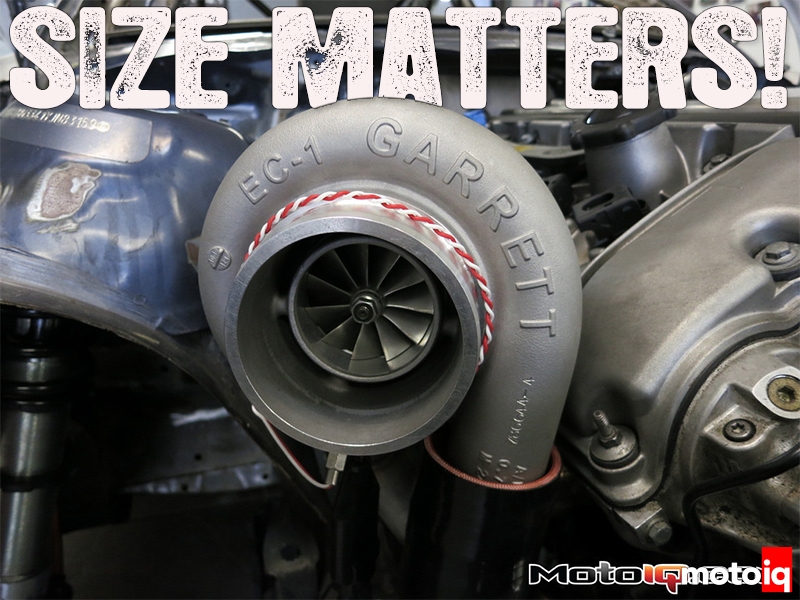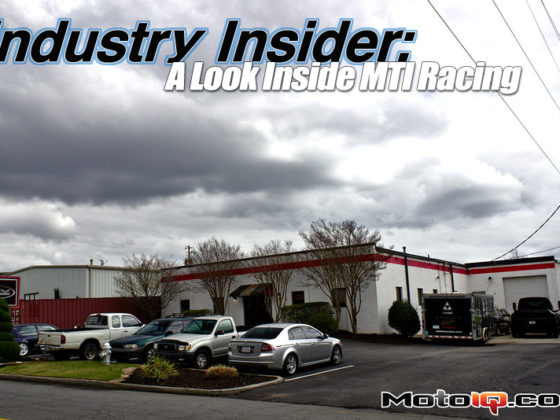,
 More torque means more power of course.
More torque means more power of course. Remember our article Turbo Tech: Compressor Efficiency and More? Here you can see what we were talking about. The smaller compressor wheel of the 6758 is operating at a low efficiency point at 8000rpm engine speed as compared to the 8734 (61% vs. 76%). The result is more shaft power is required to spin the compressor (71.5hp vs. 57.9hp). That extra shaft power ends up as heat, so you can see the higher compressor discharge temperature (329F vs. 279F) which also means your intake manifold air temperature will be higher; higher intake manifold temperatures typically mean you cannot run as much ignition timing resulting in less power. More turbo shaft power required by the compressor means more power from the turbine. If you recall our article Turbo Tech: Generating Compressor and Turbine Maps, to get more turbine power often means more turbine pressure/expansion ratio resulting in greater back pressure. This is compounded by the smaller EFRs lower turbine efficiency which means even more turbine expansion ratio for even more back pressure.
Remember our article Turbo Tech: Compressor Efficiency and More? Here you can see what we were talking about. The smaller compressor wheel of the 6758 is operating at a low efficiency point at 8000rpm engine speed as compared to the 8734 (61% vs. 76%). The result is more shaft power is required to spin the compressor (71.5hp vs. 57.9hp). That extra shaft power ends up as heat, so you can see the higher compressor discharge temperature (329F vs. 279F) which also means your intake manifold air temperature will be higher; higher intake manifold temperatures typically mean you cannot run as much ignition timing resulting in less power. More turbo shaft power required by the compressor means more power from the turbine. If you recall our article Turbo Tech: Generating Compressor and Turbine Maps, to get more turbine power often means more turbine pressure/expansion ratio resulting in greater back pressure. This is compounded by the smaller EFRs lower turbine efficiency which means even more turbine expansion ratio for even more back pressure.
 For a real-world example showing the effect of compressor efficiency on engine power, we go back to the Novak Time Attack Subaru. The dyno plots show a GTX3576R compared to a GTX3582R with the two turbos being tuned by Church Automotive to make the same power. Of course the GTX3576R spools up faster (the GTX3576R is a ~600whp turbo whereas the GTX3582R is ~725whp), but you can see for the same torque and power a higher engine speeds, the GTX3576R requires more boost pressure compared to the GTX3582R. This is due to smaller 76mm compressor having lower efficiency compared to the 82mm compressor and the high engine speed operating points. The lower compressor efficiency of the 76mm compressor means more shaft power is required from the turbine. Therefore, the turbine pressure ratio is higher resulting in greater back pressure. Thus, higher compressor boost pressure from the smaller compressor is required to make the same engine torque.
For a real-world example showing the effect of compressor efficiency on engine power, we go back to the Novak Time Attack Subaru. The dyno plots show a GTX3576R compared to a GTX3582R with the two turbos being tuned by Church Automotive to make the same power. Of course the GTX3576R spools up faster (the GTX3576R is a ~600whp turbo whereas the GTX3582R is ~725whp), but you can see for the same torque and power a higher engine speeds, the GTX3576R requires more boost pressure compared to the GTX3582R. This is due to smaller 76mm compressor having lower efficiency compared to the 82mm compressor and the high engine speed operating points. The lower compressor efficiency of the 76mm compressor means more shaft power is required from the turbine. Therefore, the turbine pressure ratio is higher resulting in greater back pressure. Thus, higher compressor boost pressure from the smaller compressor is required to make the same engine torque.Another parameter that is very important to a turbocharged engine’s performance is the backpressure from the exhaust system. The turbine wheel acts like an exhaust backpressure multiplier; hence the term pressure RATIO. If the turbine is operating at a pressure ratio of 3.0, then 2psi of pressure in the exhaust after the turbine wheel turns into 6psi before the turbine wheel. If you have 4psi after the turbine, it turns into 12psi before the turbine when the turbine is operating a pressure ratio of 3.0. So now you know why it’s critical to minimize exhaust system backpressure on a turbocharged car. Just look at any turbocharged race car such as the current F1, Indycar, and LeMans cars; they basically have short sewer pipes for exhausts to keep the backpressure to an absolute minimum.
 Using the original values for the EFR 8374 and then increasing the exhaust muffler backpressure by double, MatchBot cranks out the new exhaust manifold pressure. Run the numbers yourself, and you’ll see the increase in exhaust manifold pressure is pretty darn close to the increase in exhaust muffler backpressure times the turbine pressure ratio.
Using the original values for the EFR 8374 and then increasing the exhaust muffler backpressure by double, MatchBot cranks out the new exhaust manifold pressure. Run the numbers yourself, and you’ll see the increase in exhaust manifold pressure is pretty darn close to the increase in exhaust muffler backpressure times the turbine pressure ratio.So there you have it, the reasons why bigger turbos make more power than smaller turbos even if they are running the same boost pressure as measured at the intake manifold. As a bonus, you can now talk about how exhaust backpressure affects turbocharged engines. If you feel the need to geek out on more turbo stuff, check out a few of the articles below.
Turbo Tech: Generating Compressor and Turbine Maps
Turbo Tech: Compressor and Turbine Map Details



